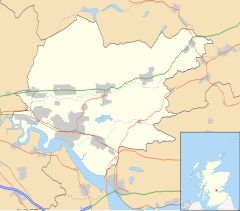Clackmannan
Clackmannan
| |
|---|---|
 Main Street and Tolbooth, Clackmannan | |
Location within Clackmannanshire | |
| Area | 0.40 sq mi (1.0 km2) |
| Population | 3,348 [2] (2008 est.) |
| • Density | 8,370/sq mi (3,230/km2) |
| OS grid reference | NS911919 |
| Council area | |
| Lieutenancy area | |
| Country | Scotland |
| Sovereign state | United Kingdom |
| Post town | CLACKMANNAN |
| Postcode district | FK10 |
| Dialling code | 01259 |
| Police | Scotland |
| Fire | Scottish |
| Ambulance | Scottish |
| UK Parliament | |
| Scottish Parliament | |
Clackmannan (/klækˈmænən/ ; Scottish Gaelic: Clach Mhanainn, perhaps meaning "Stone of Manau"), is a small town and civil parish set in the Central Lowlands of Scotland.[3] Situated within the Forth Valley, Clackmannan is 1.8 miles (2.9 km) south-east of Alloa and 3.2 miles (5.1 km) south of Tillicoultry.[4] The town is within the county of Clackmannanshire, of which it was formerly the county town, until Alloa overtook it in size and importance. According to a 2009 estimate the population of the settlement of Clackmannan is 3,348 residents.[2]
History and toponymy
The name of the town refers to the Stone of Manau[5] or Stone of Mannan,[6] a pre-Christian monument that can be seen in the town square beside the Tolbooth or Tollbooth Tower, which dates from 1592.[7]Julia Donald
The early growth of the town was due in large part to the port which lay on the banks of the tidal stretch of the River Black Devon at its confluence with the River Forth. There are now no visible signs of the port and Clackmannan now sits over a mile inland from the river. The locals tried in vain to keep their port viable by digging out the silt but to no avail .The silting up of Clackmannan's port and the fact that boats could no longer access it meant that the port in Alloa came in to use instead and this lead to an increase in the population of nearby Alloa see that town replace Clackmannan as the county town of Clackmannanshire in 1822.[8]
During the 12th century, the area formed part of the lands controlled by the abbots of Cambuskenneth. Later it became associated with the Bruce family, who, during the 14th century, built a strategic tower-house called Clackmannan Tower and in the 16th Century built a mansion alongside the tower. The mansion was demolished when local branch of the Bruces died out in 1791, although its stones may have been recycled to build the new parish church in 1815.[8] It still stands above the town according to Historic Scotland, but entry is forbidden (because of subsidence).[9]
A crater on asteroid 253 Mathilde is named after Clackmannan. Because Mathilde is a dark, carbonaceous body, its craters have been named after famous coalfields from across the world.[10] The Clackmannan Group is the name given to a suite of rocks of late Dinantian and Namurian age laid down during the Carboniferous period in the Midland Valley of Scotland.[11] The war memorial was designed by Sir Robert Lorimer in 1919.[12]
See also
- List of places in Clackmannanshire
- Clackmannan (UK Parliament constituency)
- Clackmannan F.C. Former Scottish League members
References
- ^ Mac an Tàilleir, Iain (2003) Placenames Archived 25 December 2010 at the Wayback Machine.(pdf) Pàrlamaid na h-Alba. Retrieved 29 May 2011.
- ^ a b Population Breakdown by Settlement 2009, ClacksWeb Retrieved 29 May 2011.
- ^ The Imperial gazetteer of Scotland. 1854. Vol.I. (AAN-GORDON) by Rev. John Marius Wilson. pp.270-271. https://archive.org/stream/imperialgazettee01wils#page/270/mode/2up
- ^ "Measure Distance on a Map". Free Map Tools. Retrieved 9 March 2020.
- ^ Rhys, John, Sir (1904). Celtic Britain (3rd ed.). London: Society for Promoting Christian Knowledge. p. 155. Retrieved 3 February 2018.
{{cite book}}: CS1 maint: multiple names: authors list (link) - ^ Márkus, Gilbert (2008). "Tracing Emon: Insula Sancti Columbae de Emonia". Innes Review. 55 (1). Edinburgh University Press: 3. doi:10.3366/inr.2004.55.1.1.
- ^ "Clackmannan". Gazetteer for Scotland. Retrieved 12 July 2015.
- ^ a b "Clackmannan". Undisciovered Scotland. Retrieved 9 March 2020.
- ^ "Clackmannan Tower". Clackmannanshire Council. Retrieved 9 March 2020.
- ^ "Clackmannan". We nae The Stars. Retrieved 9 March 2020.
- ^ "Clackmannan Group". British Geological Survey. Retrieved 9 March 2020.
- ^ Dictionary of Scottish Architects: Robert Lorimer
External links
- Clackmannan Library
- Clackmannan Tower: Clackmannan Towers Official Website
- ClacksNet: Clackmannanshire's Community network
- Look Aboot Ye - Clackmannanshire Community News, Information and Forums
- Clackmannan Town Hall Trust - Putting the heart back into our community
- Clackmannan Loyal - Horseshoe Bar Rangers Supporters Club

